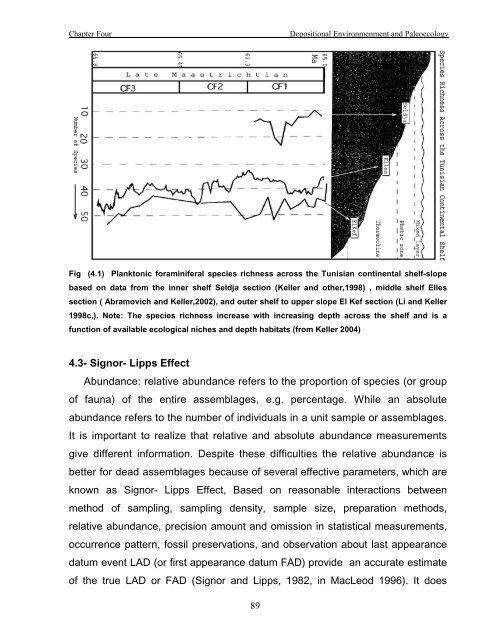biostratigraphy and paleoecology of cretaceous/tertiary boundary in ...
biostratigraphy and paleoecology of cretaceous/tertiary boundary in ...
biostratigraphy and paleoecology of cretaceous/tertiary boundary in ...
Create successful ePaper yourself
Turn your PDF publications into a flip-book with our unique Google optimized e-Paper software.
Chapter Four<br />
Depositional Environmenment <strong>and</strong> Paleoecology<br />
Fig (4.1) Planktonic foram<strong>in</strong>iferal species richness across the Tunisian cont<strong>in</strong>ental shelf-slope<br />
based on data from the <strong>in</strong>ner shelf Seldja section (Keller <strong>and</strong> other,1998) , middle shelf Elles<br />
section ( Abramovich <strong>and</strong> Keller,2002), <strong>and</strong> outer shelf to upper slope El Kef section (Li <strong>and</strong> Keller<br />
1998c,). Note: The species richness <strong>in</strong>crease with <strong>in</strong>creas<strong>in</strong>g depth across the shelf <strong>and</strong> is a<br />
function <strong>of</strong> available ecological niches <strong>and</strong> depth habitats (from Keller 2004)<br />
4.3- Signor- Lipps Effect<br />
Abundance: relative abundance refers to the proportion <strong>of</strong> species (or group<br />
<strong>of</strong> fauna) <strong>of</strong> the entire assemblages, e.g. percentage. While an absolute<br />
abundance refers to the number <strong>of</strong> <strong>in</strong>dividuals <strong>in</strong> a unit sample or assemblages.<br />
It is important to realize that relative <strong>and</strong> absolute abundance measurements<br />
give different <strong>in</strong>formation. Despite these difficulties the relative abundance is<br />
better for dead assemblages because <strong>of</strong> several effective parameters, which are<br />
known as Signor- Lipps Effect, Based on reasonable <strong>in</strong>teractions between<br />
method <strong>of</strong> sampl<strong>in</strong>g, sampl<strong>in</strong>g density, sample size, preparation methods,<br />
relative abundance, precision amount <strong>and</strong> omission <strong>in</strong> statistical measurements,<br />
occurrence pattern, fossil preservations, <strong>and</strong> observation about last appearance<br />
datum event LAD (or first appearance datum FAD) provide an accurate estimate<br />
<strong>of</strong> the true LAD or FAD (Signor <strong>and</strong> Lipps, 1982, <strong>in</strong> MacLeod 1996). It does<br />
89

















